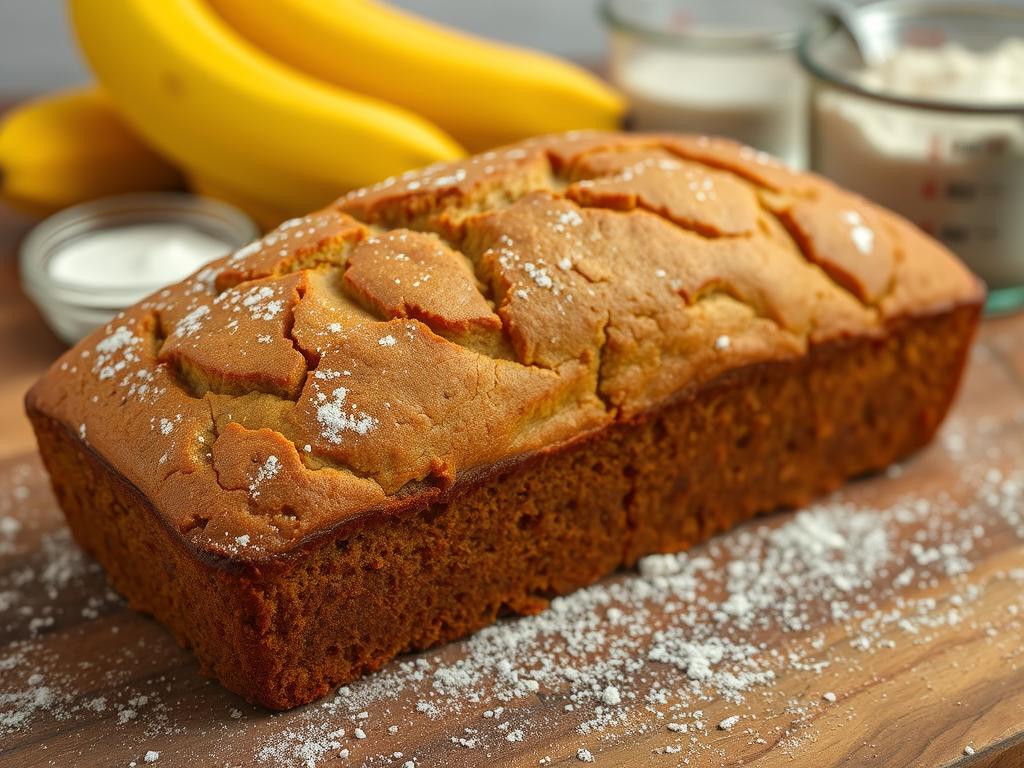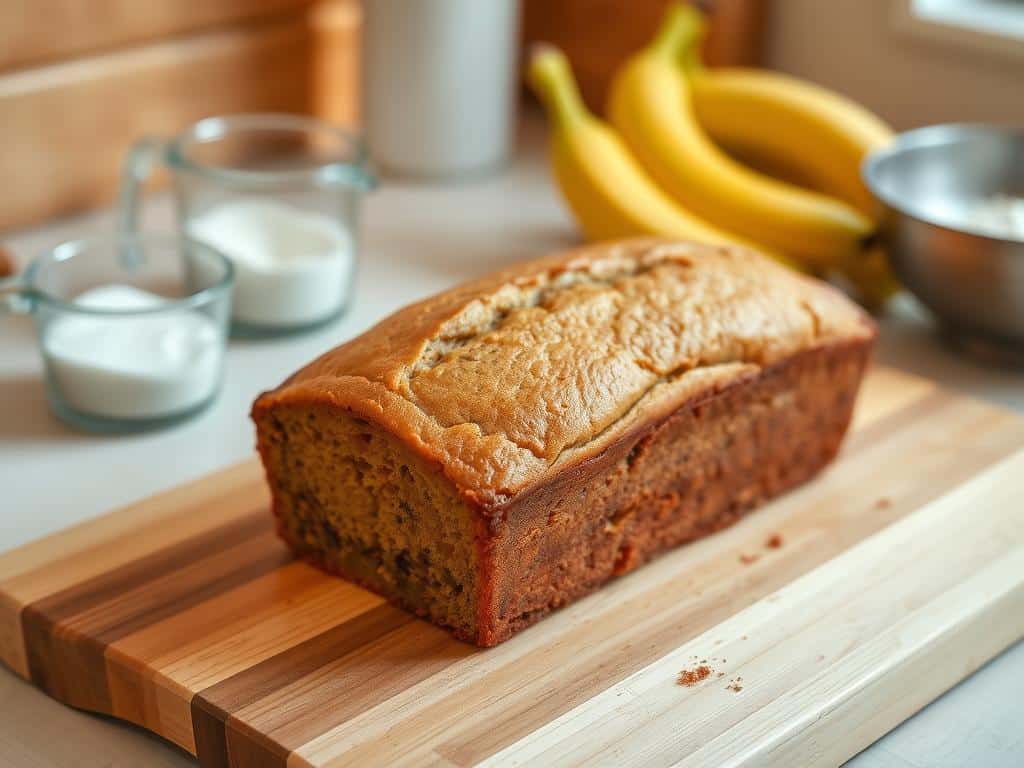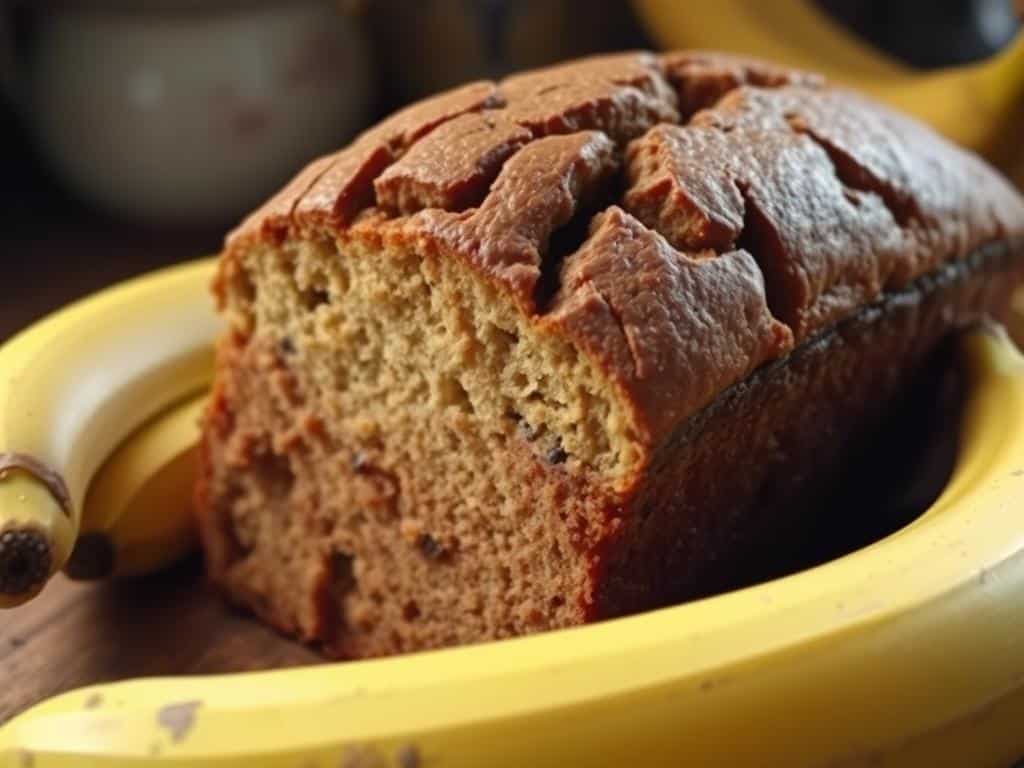Ever pulled a banana bread out of the oven, only to see cracks on top? Why does my banana bread crack on top? These cracks might not change the taste, but they can be annoying. Understanding the reason behind them can help you make a crack-free banana bread every time.
Key Takeaways
- Cracks on the top of banana bread can be caused by overmixing the batter, using too much leavening agent, oven temperature fluctuations, or an improper pan size.
- Adjusting the recipe and baking techniques can help prevent cracks and achieve a smooth, golden crust on your homemade banana bread.
- Embracing the cracks can also be an option, as they can add character and texture to your baked goods.
What causes banana bread to crack on top?
If you’ve baked banana bread, you’ve seen the top crack. This isn’t just a mistake. There are reasons why banana bread cracks. Knowing these can help you make a loaf that looks great.
Overmixing the Batter
Overmixing the batter is a main reason for cracks. Too much gluten from overmixing makes the bread rise fast and crack. Mix the batter just until it’s combined, without stirring too much.
Using Too Much Leavening Agent
Too much baking soda or baking powder can also cause cracks. These ingredients help the bread rise, but excessive amounts can lead to splitting on top. Make sure to measure carefully and use the right amount to avoid this common issue.
By understanding why banana bread cracks and making small adjustments to your baking process, you can achieve a perfect loaf every time. For more insights on baking and nutrition.
Why does my banana bread splits on top?
Seeing your banana bread split open on top can be both interesting and worrying. But, this is a common thing and doesn’t mean your recipe or baking went wrong. In fact, the splitting of banana bread is often just because the batter expands while baking.
As the banana bread bakes, the ingredients, especially the batter, grow and rise. This growth can cause a split or crack on the top. The split isn’t a sign of overbaking or a failed recipe. It’s just a natural part of the bread’s growth during baking.
The splitting of the top is often seen as a good thing in well-baked banana bread. It makes the bread look beautiful and rustic. It can also make the bread’s texture and taste better. The split lets steam out, making the inside moist and tender.
“The split on top of banana bread is a sign that the bread is baking properly and the ingredients are reacting as they should.”
So, when you see your banana bread split on top, it’s a good sign. It means your baking was successful, and you’ll enjoy a delicious, moist, and tasty treat.
Reason for cracks on banana bread
If your banana bread is cracking on the top, there could be a few reasons. Two common culprits are oven temperature changes and using the wrong pan size.
Oven Temperature Fluctuations
Sudden changes in oven temperature can cause banana bread to crack. When the oven temperature changes, it can bake the outside faster than the inside. This can lead to cracks on the top.
Improper Pan Size
Using the wrong pan size can also cause cracks. If the pan is too small, the batter can’t rise evenly, leading to cracks. If the pan is too large, the batter spreads out too thin and bakes unevenly, causing cracks.
By understanding the reasons for cracks on banana bread, such as oven temperature fluctuations and improper pan size, you can make adjustments. This way, you can enjoy a beautifully smooth-topped banana loaf.

Causes of cracked banana loaf
Baking the perfect banana loaf is a delicate task. One common problem is a cracked top. Knowing why this happens can help you bake a smooth, even loaf.
Overmixing the batter is a main cause of a cracked loaf. Overmixing creates too much gluten, making the loaf tough and dense. To prevent this, mix wet and dry ingredients gently and stop when they’re just combined.
Using too much leavening agent like baking soda or powder also causes cracks. Too much can make the loaf rise too fast. Always follow the recipe’s leavening agent amounts carefully.
| Cause | Impact |
|---|---|
| Overmixing the batter | Develops too much gluten, resulting in a tough, dense texture that cracks as it bakes |
| Using too much leavening agent | Causes the bread to rise rapidly, leading to cracks on the surface |
| Oven temperature fluctuations | Sudden changes in temperature can cause the bread to rise unevenly, resulting in cracks |
| Improper pan size | A pan that is too small can cause the batter to rise too quickly, leading to cracks |
Other factors like oven temperature fluctuations and using an improper pan size can also cause cracks. Sudden oven temperature changes can make the loaf rise unevenly. A pan that’s too small can make the loaf rise too fast, causing cracks.
By understanding these causes, you can improve your baking. This way, you can make a perfect, crack-free banana bread every time.
Why does my banana bread crack on top?
Baking at high altitudes can cause banana bread to crack. The air pressure is lower, making the bread rise and crack more. This is because the gas bubbles in the batter expand faster, leading to a quick rise and surface cracking.
To avoid cracks, you might need to tweak your recipe and baking method at high altitudes. Try reducing leavening agents, increasing oven temperature, and adjusting baking time. These changes can help achieve a smoother banana bread top.
Adjusting for High Altitude Baking
- Reduce the amount of baking soda or baking powder by 25-50%
- Increase the oven temperature by 25°F (12°C)
- Reduce the baking time by 5-10 minutes
- Consider adding an extra egg or reducing the amount of liquid in the recipe
With these adjustments, you can fight the effects of lower air pressure. This way, your banana bread will bake evenly without cracking on top.
“Baking at high altitudes can be a real challenge, but with a little trial and error, you can master the art of creating perfectly crackless banana bread.”
Preventing cracks in your banana bread
Baking a banana bread without cracks can be tricky. But, you can make changes to your recipe and baking methods to avoid those cracks. Knowing why banana bread cracks helps you make a smooth loaf every time.
Adjusting the Recipe
Too much baking soda or baking powder can cause cracks. Reducing these ingredients helps prevent the bread from rising too much. Also, avoid overmixing the batter to prevent gluten activation and cracks.
Techniques for a Smooth Top
- Use the right pan size for your recipe. A too-small pan can make the batter rise too fast and crack.
- Keep the oven temperature steady while baking. Heat changes can make the bread rise unevenly and crack.
- Gently tap the pan on the counter a few times after adding the batter. This helps release air bubbles that could cause cracks.
By tweaking your recipe and baking techniques, you can enjoy perfectly crack-free banana bread every time.

Embracing the cracks
Seeing cracks on your banana bread might not be what you hoped for. But, don’t worry. These imperfections often mean your bread turned out great. They add to the charm of your homemade treat.
Cracks on banana bread are common and many bakers love them. They show that the bread is moist and full of flavor. This split-top look is a sign of a well-made banana loaf.
“Cracks in banana bread are a badge of honor, a sign that you’ve baked something with love and care.”
Instead of a smooth top, see the cracks as a special feature. They show the bread’s moisture and density. This means it rose and baked well.
So, when you see cracks on your banana bread, welcome them. They’re a natural and lovely part of baking at home. They make your bread even more appealing and enjoyable.
Tips for perfect banana bread texture
Getting the perfect banana bread texture is all about finding the right balance. Focus on a few key factors to make a moist, tender, and delicious loaf. Even if it has surface cracks, it will still be great. The reason for cracks on banana bread often comes from the recipe and baking, not the ingredients.
Start with ripe, flavorful bananas. The more brown spots, the sweeter and richer the flavor. This is key for a moist, rich banana bread. Don’t use underripe bananas, as they won’t add the same sweetness and moisture. Learn more about the nutritional benefits of bananas from heart.org .
Then, balance your wet and dry ingredients carefully. Too much flour makes it dry and crumbly. Too much liquid makes it dense and gummy. Make sure to measure each ingredient right.
Finally, bake at the right temperature and time. Fluctuations in oven temperature or taking it out too soon can cause cracks. Stick to the recipe and adjust if needed for the perfect texture.
By following these tips, you can make banana bread that’s moist, tender, and full of flavor. Don’t worry about the cracks. Just enjoy the delicious outcome of your baking, Learn more how to make classic banana bread .
Conclusion
Cracks on banana bread tops are common but don’t mean you failed. Knowing why they happen helps you fix them. Causes include overmixing, too much leavening, oven issues, and wrong pan sizes.
Fixing these problems leads to better banana bread. Use quality ingredients and keep your baking consistent. This way, you can have a smooth, golden crust, whether you like the cracks or not.
Becoming a better baker means tackling common issues. Try new recipes, watch your oven, and pick the right pans. With practice, you’ll make banana bread that looks and tastes great.
The fun of baking is in the journey, not just the end result. Learn from each try, even if it’s not perfect. Happy baking!
FAQ
Why does my banana bread crack on top?
Banana bread cracks can happen for many reasons. Overmixing the batter is one. Too much leavening agent is another. Oven temperature changes and the wrong pan size also play a part. Knowing these causes can help you get a smooth crust on your banana bread.
What causes banana bread to crack on top?
Overmixing the batter can make too much gluten. This leads to cracks. Too much baking soda or powder can also cause the bread to rise too fast and crack.
Why does my banana bread split on top?
The bread can split on top because the batter expands while baking. This is normal and doesn’t mean there’s anything wrong with the recipe or how it’s baked.
What is the reason for cracks on banana bread?
Sudden oven temperature changes can cause cracks. Using the wrong pan size can also lead to uneven baking and cracks.
What are the causes of a cracked banana loaf?
Cracks can come from overmixing the batter or using too much leavening. Oven temperature changes and the wrong pan size also cause issues. Knowing these can help you bake a smooth banana bread.
Why does my banana bread crack on top when baking at high altitude?
Baking at high altitudes can make banana bread crack more. The lower air pressure makes the bread rise and crack more easily.
How can I prevent cracks in my banana bread?
To avoid cracks, try reducing leavening agent or mix gently. Use the right pan size and keep the oven temperature steady. This can help your banana bread have a smooth top.
Should I embrace the cracks in my banana bread?
Cracks on banana bread might not look perfect, but they’re not a sign of a bad recipe. Some people even like the cracks as a natural part of homemade banana bread.
What are the tips for achieving the perfect banana bread texture?
For the perfect banana bread, use ripe bananas and the right mix of wet and dry ingredients. Bake at the correct temperature and time. These tips will help you make a moist, delicious banana bread, even if it has some cracks.

